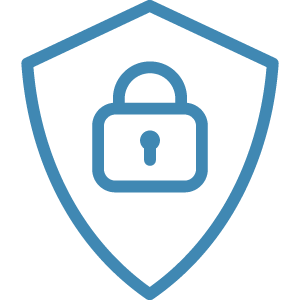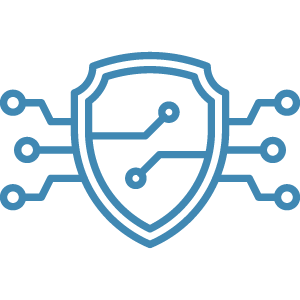Cybersecurity isn’t just an internal issue. It extends to partners and portfolio companies in your network as well. The more access points into your system, the more opportunities there will be for cybercriminals to seek out and take advantage of weak points in your systems. For private equity firms, those weaknesses could lead to damage to your data integrity, business continuity, finances, and reputation, to name a few. The challenge many private equity firms face is ensuring a secure, interconnected network of data streams and systems with portfolio companies, without incurring additional cybersecurity risk.
To best mitigate cybersecurity risk, teams must first understand the cybersecurity threat landscape.
Cybersecurity Threats Affecting PE Firms
Cybersecurity threats come in many forms, but most with the same goal – to disrupt operations, steal or lock down data, and obtain a monetary “reward” for their malicious activity. Some of the most common cybersecurity threats include:
- Phishing
- Ransomware
- Malware
- Insider threats
- Cyber espionage
- Man-in-the-Middle attack (MITM)
- Distributed Denial of Service (DDOS) attack
Phishing
The most common form of cyberattack is called Phishing. In fact, according to the Federal Bureau of Investigation (FBI), phishing was the number one crime type in 2022. And, USA Today reports that “more than 90% of cyber-attacks are initiated as a result of a phishing email.”
In a phishing scenario, a bad actor will attempt to collect sensitive information (e.g., user credentials, credit card information, bank account number) from an employee via email, text message, or phone call. The outreach is intended to look like it came from a trusted source and crafted with a sense of urgency to entice immediate action. That action may be to reply with the requested information, or even to click on a link or attachment for the next steps.
Ransomware and Malware
Once connected to your business, either through phishing or another inlet, cybercriminals can install malicious software known as malware or ransomware. Ransomware software is intended to seize control of your data or operating systems, holding them “hostage” until a ransom is paid. Malware software is similar in its malicious intent, causing disruptions to a business’ computers, servers, or networks.
According to VirusTotal, more than 130 ransomware strains have been detected since 2020, and Verizon’s Data Breach Investigations Report noted that ransomware was involved in 24% of all breaches in 2023. Regarding malware, reports show 560K incidents of malware detected every day, with trojan viruses accounting for 58% of all malware.
Unfortunately, recent reports from Cybereason show that “84% [of organizations] paid the ransom. But 78% were then breached again, and 63% of these were asked to pay even more the second time.” Although it may be tempting to pay the ransom so you can regain access to your data and business operations, it will likely hurt your business in the long run. The best course of action (for both ransomware and malware) is to increase protection around any digital entry points (e.g., email, external storage drives, applications), provide security training for employees, patch software to ensure a high level of security and engage with security experts like GainSide to ensure all of your security needs are met.
Insider Threats
The Cybersecurity and Infrastructure Security Agency (CISA) defines insider threat as “the threat that an insider will use their authorized access, intentionally or unintentionally, to harm the department’s mission, resources, personnel, facilities, information, equipment, networks, or systems.”
An “insider” is someone within the organization who knows and/or has access to secure systems or networks and other sensitive information. While human error can contribute to cybersecurity risk (e.g., accidental exposure of the organization’s systems or data as a result of phishing or other social engineering attacks), an internal threat also may exist from a person knowingly putting the organization at risk or stealing proprietary information for their gain. These intentional threats are premeditated and may involve identifying IT weaknesses, obtaining protected information, or even installing malicious software (e.g., malware or ransomware) to disrupt systems and networks. Although it is difficult to predict who may become an internal threat, organizations can monitor activity and ensure role-based access control measures are in place to limit unnecessary access.
Cyber Espionage
As the name suggests, cyber espionage is the malicious theft of sensitive or classified data, either for some form of competitive advantage or financial gain. Some of the most common forms of data targeted in these attacks include strategic plans, research data, product formulas or blueprints, and client lists. Cyber espionage may be initiated through a variety of cyberattack methods including phishing or other social engineering attacks, insider threats, or ransomware.
Man in the Middle Attack
A Man in the Middle (MITM) Attack occurs when a cybercriminal inserts themselves between two entities in communication with the intent of stealing data. This often occurs when a user connects to an unsecured or unknown network (e.g., coffee shop, airport). The individuals communicating via this network are unaware that another party is present during their conversation and extracting data. The cybercriminal often looks for financial information that can be sold on the dark web.
Two common types of MITM attacks include:
- WiFi eavesdropping: Cybercriminals may establish a wireless network with a legitimate-sounding name, enticing individuals to connect. Once connected, cybercriminals will be able to collect sensitive information (e.g., user credentials, and financial data).
- Session hijacking: When an individual connects to an unsecured network, a cybercriminal may use this as an opportunity to steal the cookie associated with a specific application (e.g., a banking app). This cookie will allow them to re-enter that application and conduct malicious activities.
In today’s virtual work environment, connecting to wireless networks is commonplace. Unfortunately, not all networks are safe. To ensure your business remains safe and secure, even on public wireless networks, be sure to always connect through a VPN network, which allows you to safely work with encrypted data.
Distributed Denial of Service (DDOS) attack
A DDOS attack occurs when a cybercriminal attempts to overload and overwhelm the bandwidth and resources of a specific server, website, or system, causing performance issues or even taking it offline altogether. As a result, cybercriminals can use this opportunity to gain access to the organization’s database to access sensitive data or other information.
Risk Mitigation Strategies
Cybersecurity threats are prevalent in today’s virtual business world. According to the Cyberthreat Defense Report, 84.7% of organizations reported at least one cyberattack in 2023, and nearly 40% experienced six or more successful attacks. And, according to Sophos State of Ransomware 2023 report, 68% of organizations in the US experienced a ransomware attack, up from 59% in 2020. Further, Verizon’s 2023 Data Breach Investigations Report estimates that “74% of all breaches include the human element, with people being involved either via error, privilege misuse, use of stolen credentials or social engineering.”
The risk is undeniable, but it’s not insurmountable. Private equity firms can mitigate cybersecurity risk by employing the following strategies:
- Adopt robust security protocols, including firewalls, password management, data encryption, and others.
- Monitor user and network activity to identify any unusual or suspicious activity and detect potential breaches.
- Establish an incident response plan that identifies roles and responsibilities, notification and escalation plans, procedure steps, etc.
- Conduct vulnerability and penetration testing to identify weaknesses that the team can proactively address.
- Ensure proper patch management to strengthen software and systems and eliminate weak points.
- Outsource cybersecurity to specialized teams – like GainSide – to help balance the workload on internal teams and ensure a high level of cybersecurity expertise and protection.
Cybersecurity Readiness: Key Questions to Ask Portfolio Companies and Partners
Looking beyond your internal walls of cyber protection, how confident are you in the cybersecurity readiness of your portfolio companies and partners? Following are 9 key questions to help determine their level of risk:
- What cybersecurity software or systems do you currently have in place?
- Does your organization use two-factor authentication?
- What type of cybersecurity training do you currently provide, and how often?
- Who is responsible for maintaining/patching your software and systems?
- Where and how often is data backed up?
- How are you notified of suspicious activity?
- What signals are in place to alert to a data breach?
- What is the business recovery plan as it relates to a data breach?
- How are partners (or in this case, your PE firm) informed of data breaches and next steps?
Don’t be afraid to dig into their security practices. Your portfolio company is an extension of your firm. It is not unreasonable to require a high standard of cybersecurity. And, if they are lacking in a specific area, it’s best to know at the onset of the relationship so you can put proper security measures in place to mitigate the risk.
Why GainSide
Private equity firms are responsible for high volumes of sensitive data, with large financial implications spanning a wide range of deals. Although it’s impossible to predict when or how a cybercriminal will attempt to gain access to your system or extort data, it is possible to proactively increase protections against their malicious attempts. The first step is to adopt a multi-layer cybersecurity approach. The selection of the proper tools is critical. Unlike a typical managed service provider (MSP), GainSide provides full transparency into the specific tools used to protect our customers. For example, our core protection suite includes:
- Secure internet access
- Email and information protection
- Drive and email backup
- Antivirus with detection and response
- Training and testing
- Mobile device management
Within these areas, we select the best solutions, strategies, and partners to meet our customers’ unique needs. Security is essential, especially in today’s environment. At GainSide, our clients don’t just gain enhanced security and a suite of proven solutions, they gain a true strategic partner to support their ongoing security needs.
To explore how GainSide can help your business avoid potential cyberattacks, simply request a consultation.






